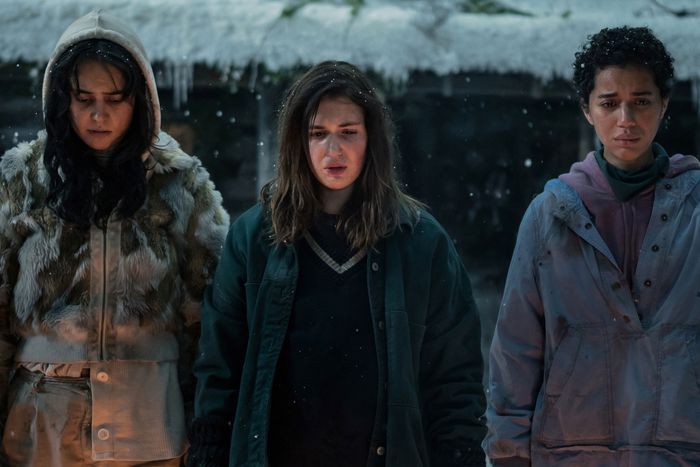
In its first season, Yellowjackets walked a line as fine as the muscle fibers composing meat grain. Every episode was a delicate balance between oppositional explanations for the violent and spooky goings-on in 1996 and the damaged women struggling to make sense of their pasts in 2021: “Surely the surviving Yellowjackets are experiencing a traumatic mass delusion, and nothing supernatural or cannibalistic happened in that corner of the Canadian woods” as one speculation, and, “The forest is sentient, and full of malicious intent” as another.
This approach could feel precarious, as if one step off a forest trail or outside a suburban cul-de-sac could upset the equilibrium Yellowjackets was working so hard to achieve. But the second season offers proof that the series is built to last by winking at both of those contradictory theories, offering answers for some of the show’s myriad arcana while inventing new ways to prolong tension, and revealing more of its characters’ inner workings while building out the nightmares in which they’re trapped. Yellowjackets sometimes attempts so much that it trips over itself, like a fumbled fast-break play on the soccer field. But between its confident willingness to get weird — sinister trees, bloody bees, pernicious facsimiles! — and its relatively sure grip on its world-building, Yellowjackets is making a compelling case for its own longevity.
Certain things that happened in the first ten episodes of Yellowjackets are inarguable. The girls’ varsity soccer team from a high school in Wiskayok, New Jersey, crashed in the Canadian wilderness while traveling to the national championships in Seattle in 1996. Some players died when the airplane went down, and others died over the 19 months they were stranded out there. In 2021, a number of those women still live in their hometown under a shadow of infamy: housewife Shauna (Melanie Lynskey), married to her dead best friend Jackie’s (Ella Purnell) high-school boyfriend, Jeff (Warren Kole); lawyer and newly elected state senator Taissa (Tawny Cypress); recovering addict Natalie (Juliette Lewis); and nursing-home aide and citizen detective Misty (Christina Ricci). They’ve never really talked about what went on in the woods, instead sticking to a vague skimping-and-starving story whenever journalists or writers came asking for interviews, and co-creators Ashley Lyle and Bart Nickerson and their fellow showrunner Jonathan Lisco integrated that hesitance and uncertainty into the series’s DNA.
“One of the things the show is trying to do is play with the subjectivity of experience. … It’s fair game to ask whether or not a thing you’re seeing is happening, because there are ways that experience, like past and present and future, can be warped,” Nickerson told Vulture, and that’s a succinct description of the first season. But season two (which premieres March 24, with six of ten episodes provided for review) intentionally loses some of that uncertainty, and the series unraveling a few of its long-running ambiguities makes for an agreeable change of pace — a sign of Yellowjackets having enough trust in its own concept and in its ensemble to pull off big narrative gambles and emotional swerves.
The season begins with varying time jumps since the events of season-one finale “Sic Transit Gloria Mundi.” In 2021, a couple days have passed since the disappearance of Shauna’s lover, Adam, made the news; Taissa was elected to New Jersey’s state senate; Misty killed a faux journalist; and Natalie was kidnapped by purple-outfitted cultists wearing pendants of the forest’s mysterious triangle symbol. In 1996, it’s been two months since Jackie froze to death and winter has fully arrived, with multiple feet of snow on the ground, no game for Natalie (Sophie Thatcher) and Travis (Kevin Alves) to hunt, and Javi (Luciano Leroux) still missing. In both timelines, the groups are beginning to fracture, their fault lines crafted by law and order, occult-ish spirituality, and self-destruction; the two settings remain in tension so each character’s choices, now and then, complement and enhance each other.
Take Tai, who despite girlfriend Van (Liv Hewson) tying them together each night is still sleepwalking, with no awareness of what she’s doing; in the present, Tai’s chunks of lost time are getting more drastic. Both Jasmin Savoy Brown and Cypress do phenomenally creepy and heartbreaking work as distinctly different versions of Tai, with Brown and Hewson’s ribbing of each other also adding some welcome humor to all this macabre. Also well-done are the arcs that take characters in unexplored or demanding directions, like Lewis’s Natalie tumbling into a self-help journey that she surprisingly doesn’t entirely write off, and Courtney Eaton’s Lottie embracing woo-woo wilderness worship to a far more unsettling degree than in season one. Without getting into spoiler territory, the oddities of 1996 now have more clear effects in 2021, with grotesque visuals and immersive sound design that play up the series’s established iconography (bee boxes dripping like viscera, that ominous antler queen crown, mirror images that move on their own, whooshing and seemingly sentient wind) and prompt us to interrogate how much of what we think we remember is actually what we imagine. And the needle drops, while more rapidly consecutive than they need to be, would once again make a great playlist, with Tori Amos, Veruca Salt, Garbage, and Elliott Smith among the highlights.
Does some unwieldiness arise from the series’s desire to have every character confront who they want to be versus who they actually are, and its choice to dedicate screen time to every plot point, from incongruously mossy trees in the past to the pet goldfish of one of Lottie’s followers in the future? Increasingly so, yes. It’s perhaps too much of a stretch to accept that there are a half-dozen or so survivors in 1996 that we haven’t noticed before, but here they are. Yellowjackets explains it away by having these girls call the main characters from season one so self-involved that they didn’t pay attention to anyone else, but while that kind of lampshading is audacious, it doesn’t lessen the clumsiness of these characters’ integration into the established group.
Also awkward is the way the series undercuts the impact of adult Lottie (Simone Kessell) by immediately working her into the narrative and maneuvering others around her, instead of more gracefully engineering anticipation for her debut. (Adult Van, played by Lauren Ambrose, gets a more measured entrance.) The early episodes, heavily tipped toward Lottie as she “goes all witch-doctor messiah,” in the words of teen Natalie, almost feel like they’re trying to reassure viewers that Yellowjackets won’t clarify too much. But Lottie’s quirkiness threatens to disrupt the ensemble’s balance, especially compared with the Shauna/Jeff subplot. Although Lynskey and Kole haven’t lost any of their chemistry as a barely-hanging-on married couple, as the season continues, their involvement in covering up Adam’s death feels siloed off (and sometimes slightly illogical) because it’s so far from Lottie’s reach.
These aren’t disastrous failures, but they are distractions from the series’s otherwise-dexterous willingness to get grislier with its gore, pricklier with its relationships, and cheekier with its humor. Yellowjackets still knows how and when to undercut its darkness with character-specific levity, and those flourishes nearly all land: Kole’s Jeff zealously rocking out to Papa Roach; Ricci’s Misty arguing about the best musical cast recordings with a new frenemy played by Elijah Wood; Lynskey’s Shauna warning Jeff’s best friend that he better not think about her while masturbating. This nimbleness indicates an ambition that could serve the series well in its planned five seasons, if it does get the episodic order Lyle and Nickerson want. Until then, Yellowjackets’ comfort with being discomforting is to its ongoing benefit, and ours.





